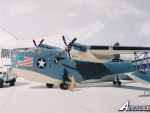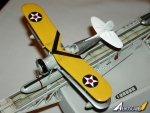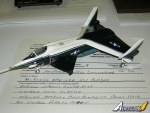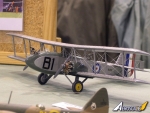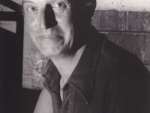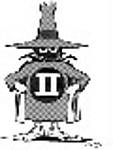The RAREplanes Story - Part 2
1
Comment
As I have said before, the business originated from my small home near Redhill, in Surrey and long
before, as I recollect, the descriptive term ‘cottage industry’ was popularised. But that was what it
was, with my wife Janet and our two children helping where they could. A stroppy Irish neighbour of
mine complained to the local council - because it was his duty to report ‘industrial blight’ and, sure
enough, along came the council man who was fascinated to find such an interesting operation going
on. There being no industrial messes, he blessed us and went on his way. But not all officials were
welcome. One that made me creep was a Purchase Tax Inspector who took over my work table each
month to check my returns. Since a great deal of my output went overseas it did not attract tax so
that, to a qualified accountant, the British sales being modest would take no more than ten minutes
to calculate. But he sat there for the full three hours, drinking tea and occasionally snoring, then
berated me for a halfpenny mistake. It was a relief when VAT arrived and my tax was sent by cheque
and Mr PTI was hung out to dry. On the other hand, many people in business when they knew what I
was doing were immensely interested and pulled out every stop to help; it was wonderful what a
smile and a little charm could do in expediting deliveries of bulk supplies of plastic, print or paper (or
payment of an invoice). Even bank managers recognised me and patted me on the head!
Six months after my company started I had the need to expand and an extention to my house filled the bill - but my Father was horrified at the cost since I was ‘only playing with model aeroplanes’. Six years later we had to find more space and so moved a mile down the road to Redhill and paid off the house mortgage. Now, a new addresss can be the kiss of death to anyone in mail-order and I had first hand experience of an excellent model shop in Orpirigton that also moved a mile down the road - and failed inside six months. Perhaps I was fortunate with Redhill because I found a styrene sheet manufacturer on my doorstep, who would cut, pack and store a ton at a time that I could draw from and my rejects could be recycled. I also bought a couple of tons of perfumed glossy white styrene from Italy which was a heady delight to use. But transparent material was always a problem; I started with marvellous CAB cellulose acetate butyrate which formed sharply, was crystal clear and cut so cleanly it opened up a new use where I used a thicker gauge for fuselages, which incorporated all windows. A DH89 Rapide was the first to get a clear body, then the nacelles of the Bell Airacuda, the Fokker G-i centre section and a Bell Jetranger followed. Although a neat solution to the problem, it never caught on because acetone had to be used as an adhesive, but it worked. Thin CAB was ideal for small canopies, however it was somewhat inflammable, so it was eventually withdrawn by the manufacturer and we had to use PVC, a far from ideal material but the only thing available at the time - PETG copolyester was far in the future. Trying to keep up a decent standard of kit began to be a sore headache. Most of my competitors did this for spare time work or for the fun of it but I was reliant on a steady income to maintain my family and business, luckily, sales remained bouyant throughout the life of RAREplanes and it was all I could do to keep up with them.
Another bright idea came to me in the mid-1970s that I named Paint- a- Puffer, it was a 3D forming of a well-known steam locomotive set in a picture frame - you to add paint (by numbers) and then hang on the wall as decoration. It looked attractive, kids would love it. Somehow Rothschilds Bank got to hear of it and a team of hot- shot commercial enterprise guys came to my home offering me large amounts of money to develop a range of subjects. The thought of commissioning a factory, workforce, machines and mass materials was totally thrilling but I was told to drop RAREplanes, concentrate entirely on the new company, work 24 hours each day to pay back the loan and, to forget I ever had a family life. But.... I could have a Rolls on the drive by next year. I was given two weeks to decide on signing up - such temptation - however, my love of aircraft won the day and so I walked away. A similar bright idea was worked up and submitted to Airfix, where a 3D side profile of an aircraft was modelled, painted and attached to a wall. Whilst the commercial possibilities were appreciated by them, they had not the capacity to take it on and as they realised that time was wasting, suggested other firms would happily take it on board. One venture that my factory-owner friend started was a cast metal mould taken from my Stinson Sentinel masters. It needed some fettling to get it fit for injection moulding but, within a few weeks, he’d sold his house and factory and took ship for the shores of America. So once more a bright idea hit the buffers and the heavy block became a useful doorstop for some time to come. When I did buy a small plastics injection moulder in the later 80’s, I used poured-resin moulds and a metal additive that, when cured, gave a good hardness but did not last long. That was when my hair started to go grey. Many other ‘initiatives’ occurred over the 20 years, all of them interesting to be sure, but nothing that could possibly deter me from producing vacuum-formed kits. Perhaps my weakness was that I was more of an artist and not an engineer.
It was January 1975 when I made my first big vacform kit, the beautifùl Lockheed C-121 Constellation design spanning 21 inches. Legend had it that Airfix did not make a real profit on its aircraft kits until it made a four engine bomber, the Lancaster, so I was interested to see if the story would work for me. Sure enough, the first 500 kits sold inside 3 months, a second 1000 in 5 months and a further run ended the year by which time I followed up with another four-motor, the early version of the Flying Fortress, known as the YB-17A (some 35 years later, you will find a pair being constructed ¡n great detail on the Internet ARC Forum). These modelling chat forums with accompanying photographs are wonderful timewasters at my age, but they do have very nice things to say about the kits that came from my workbench, so I enjoy looking at them and seeking out the reviewers of my planes. Some of the words used such as ‘gem’, ‘genius’ and ‘master’ are pushing it a bit, but I will accept ‘a pleasure to build’, ‘the equal of some injection kits’, ‘well engineered and very accurate’ as being music to my ears. But please don’t ask - I have no old samples tucked away for a rainy day. How did I stumble into this business? What were my qualifications? Not a lot, obviously as several hundred wannabees did the same thing. My influences were a Father who worked as a carver in the wood trade and who spent time with the Royal Flying Corps ¡ri WW1. A brother who taught me to draw aircraft really well. The Air Age of the 1930s where the Graf Zeppelin thundered over my own hometown looking like a monster spaceship and we earthlings delighted in the yearly visits of Alan Cobhams Flying Circus. Wonderful Skybird and Frog kit models in my local toyshop. Aviation pulp magazines from the USA. Oh, and the discovery of balsawood! I hacked lumps of balsa into crude model fighterplanes - and sold them to friends for sixperice. At art school for a couple of years, I learnt a little about drawing and design and then was put to a war factory as an inspector of the new Mosquito wooden aircraft (with an unlimited supply of scarce balsawood). The final years of WW2 saw me in London amid the buzz-bombs, as a 3-view draughtsman for the famous series of wartime planbooks known as ‘Aircraft of the Fighting Powers’. From there, in late 1945 I served with the RAF in Jerusalem, Palestine as part of the Air Command Staff,Eastern Mediterranean (slightly bombed and shot at until we were booted out in 1948). The years that followed were vexed as my artistic carreer was drastically curtailed through losing the sight in my left eye and endless painful visits to hospitals were unable to find or slow the cause. So I floundered through life as a one-eyed graphic designer-artist-cum-publicity man and somehow acquired, along the way, a beautiful wife, some children, a house, mortgage - and the inevitable lucky black cat.
Christmas 1954 brought my very small nephew a huge gift of Reveil plastic model kits from a rich godfather in the USA, a first view of these newfangled toys. The poor boy didn’t know how to start and so I was asked to show him the way and had a lot more fun than him in constructing Voodoos, Supersabres and DeltaDarts which started me on the road to the amazing world of plastics. Alas, the next ten years of my spare time were taken up in gardening, house decoration and moonlighting on small design jobs so only rarely did I construct the odd plastic model plane, a cheapie, whatever Woolworths store had on offer. And then in mid-1966 I found the International Plastic Modellers Society - and thats where we came in.
Was it worth it? There is no doubt that most model aircraft nuts would give their all to have such a job as mine was, whatever the rewards. 30 years of creating pleasure for hundreds of appreciative customers is a pretty gratifying prospect and that made the slogging production work, the 15-hour days, all-night sessions nursing overheating moulds and many frustrating setbacks when nothing seemed to go right all worth while enduring. At least, you were in total control of your life and work and that gave a great feeling of freedom and satisfaction worth a fortune. Fortunately, during this long term of self-employment I was lucky to keep pretty healthy and was at my work-desk at 9am every day, had no money worries (never enough of course), did all my motoring at off-peak hours, took time away for enjoyment with Janet, my very understanding and supportive wife, and tried to notice my growing daughters (the boyfriends had actually heard of ‘Mr RAREplanes’!). There is not much more one can ask for in life. And who else could create a model kit and be the very first to make it up? That was a thrill I had the pleasure of experiencing well over a hundred times.
When Hannants took over the production and sales of RAREplanes in1989 it was the premier brand of all vacforms and was retailed in most civillized countries of the world, however, to keep up with the latest trends it was decided to include decal sheets and metal parts in the most popular items. An ongoing programme of improvement included stronger boxing and the commissioning of several moulds of much-needed subjects which kept the range well ahead for another ten year span of life. However, at the start of the new century, the rapidly-expanding Czech/Polish manufacturing empire (that evolved by making vacform kits) suddenly blossomed like a genie out of a bottle. It was soon brimming with sharp resin kits and short-run injection-moulded products to take over making the less well-known types of aeroplanes and those of smaller countries, so making the vacform almost redundant in a very short time. RAREplanes and most others had disappeared after the year 2000. Though even today, there are modellers out there desperate to get hold of a RAREplane Mariner, Coronado or Boeing YB-17 - they say they are better than injection moulded items! These internet modelling forums have thrown up more than a hundred illustrated reviews of my old kits - that are quite complimentary, thank you very much - and the model planes look so good in colour. A nice tribute ( but still no money).
Did the vacuum-formed model kit come in with a bang and go out with a whimper? My guess is the answer to that is a definate ‘Yes’, although there are still some brave souls out there such as Khee Kha, AiM, Broplan, but the vast majority are no longer with us - only the small sad remnants of our revolution are to be found on Ebay. Nevertheless, I must confess that my researches into this remote subject have turned up some interesting facts that show my claim of being first on the vac scene to be wishful thinking! For example, I have found a reference to some 1/144 scale kits in Great Britain called Wimco Hollows, some sort of vacforms, and marketed by Sebel Products who seem to have issued three aircraft, the Javelin, Valiant and Canberra from 1956 until 1967 ( a bit unlikely, but so says the famous kit chronicler John Burns). They must have been pretty thin on the ground for only in 1973 did I catch a fleeting sight of some cut out shapes in a carton at an IPMS meeting and never saw the final result, maybe not surprising as that scale wasn’t popular at the time. More interesting was the revelation that Bill Koster in the USA had used the process for his 1/48 scale conversion kits starting in 1966 but his wares were virtually unknown in Britain so there was little to really set our world alight. I never saw one until a modified Fortress was pointed out in 1972 as being a Koster conversion. Yet in America things had been different: looking back on some internet modelling sites, moulded sheet plastic - maybe celluloid - had been used for ready-made flying models before World War 2 according to old ‘Selley-Tex’ adverts. Post-war big scale flying models, such as the superb Berkeley and Guillow kits, had certain parts like cowlings and engines moulded from thermo plastic and later companies such as Strombecker, Lindberg and Hobbytime offered rubber -power scale flying models with light plastic bodies and wings (that did not do well in a crash dive). And in the last 30 years there have been many ready-to-fly boxed u-control models using the vacuum-formed moulding process, including helicopters and spacecraft. I also used some vacformed sails on my display model sailing boats to good effect and have heard that the process was also used to fashion the bodies of model airships by Frog and Aurora. Then there was the slot car special auto bodies and the preformed boat hulls, the diorama groundworks, wargame and lineside scenery, etc, - and so it goes on -
Maybe I and RAREplanes were latecomers but we did kick off the BIG world vacform revolution!
With thanks to Jim Lund for his kind permission to use his photos of many of the models shown.
Six months after my company started I had the need to expand and an extention to my house filled the bill - but my Father was horrified at the cost since I was ‘only playing with model aeroplanes’. Six years later we had to find more space and so moved a mile down the road to Redhill and paid off the house mortgage. Now, a new addresss can be the kiss of death to anyone in mail-order and I had first hand experience of an excellent model shop in Orpirigton that also moved a mile down the road - and failed inside six months. Perhaps I was fortunate with Redhill because I found a styrene sheet manufacturer on my doorstep, who would cut, pack and store a ton at a time that I could draw from and my rejects could be recycled. I also bought a couple of tons of perfumed glossy white styrene from Italy which was a heady delight to use. But transparent material was always a problem; I started with marvellous CAB cellulose acetate butyrate which formed sharply, was crystal clear and cut so cleanly it opened up a new use where I used a thicker gauge for fuselages, which incorporated all windows. A DH89 Rapide was the first to get a clear body, then the nacelles of the Bell Airacuda, the Fokker G-i centre section and a Bell Jetranger followed. Although a neat solution to the problem, it never caught on because acetone had to be used as an adhesive, but it worked. Thin CAB was ideal for small canopies, however it was somewhat inflammable, so it was eventually withdrawn by the manufacturer and we had to use PVC, a far from ideal material but the only thing available at the time - PETG copolyester was far in the future. Trying to keep up a decent standard of kit began to be a sore headache. Most of my competitors did this for spare time work or for the fun of it but I was reliant on a steady income to maintain my family and business, luckily, sales remained bouyant throughout the life of RAREplanes and it was all I could do to keep up with them.
Another bright idea came to me in the mid-1970s that I named Paint- a- Puffer, it was a 3D forming of a well-known steam locomotive set in a picture frame - you to add paint (by numbers) and then hang on the wall as decoration. It looked attractive, kids would love it. Somehow Rothschilds Bank got to hear of it and a team of hot- shot commercial enterprise guys came to my home offering me large amounts of money to develop a range of subjects. The thought of commissioning a factory, workforce, machines and mass materials was totally thrilling but I was told to drop RAREplanes, concentrate entirely on the new company, work 24 hours each day to pay back the loan and, to forget I ever had a family life. But.... I could have a Rolls on the drive by next year. I was given two weeks to decide on signing up - such temptation - however, my love of aircraft won the day and so I walked away. A similar bright idea was worked up and submitted to Airfix, where a 3D side profile of an aircraft was modelled, painted and attached to a wall. Whilst the commercial possibilities were appreciated by them, they had not the capacity to take it on and as they realised that time was wasting, suggested other firms would happily take it on board. One venture that my factory-owner friend started was a cast metal mould taken from my Stinson Sentinel masters. It needed some fettling to get it fit for injection moulding but, within a few weeks, he’d sold his house and factory and took ship for the shores of America. So once more a bright idea hit the buffers and the heavy block became a useful doorstop for some time to come. When I did buy a small plastics injection moulder in the later 80’s, I used poured-resin moulds and a metal additive that, when cured, gave a good hardness but did not last long. That was when my hair started to go grey. Many other ‘initiatives’ occurred over the 20 years, all of them interesting to be sure, but nothing that could possibly deter me from producing vacuum-formed kits. Perhaps my weakness was that I was more of an artist and not an engineer.
It was January 1975 when I made my first big vacform kit, the beautifùl Lockheed C-121 Constellation design spanning 21 inches. Legend had it that Airfix did not make a real profit on its aircraft kits until it made a four engine bomber, the Lancaster, so I was interested to see if the story would work for me. Sure enough, the first 500 kits sold inside 3 months, a second 1000 in 5 months and a further run ended the year by which time I followed up with another four-motor, the early version of the Flying Fortress, known as the YB-17A (some 35 years later, you will find a pair being constructed ¡n great detail on the Internet ARC Forum). These modelling chat forums with accompanying photographs are wonderful timewasters at my age, but they do have very nice things to say about the kits that came from my workbench, so I enjoy looking at them and seeking out the reviewers of my planes. Some of the words used such as ‘gem’, ‘genius’ and ‘master’ are pushing it a bit, but I will accept ‘a pleasure to build’, ‘the equal of some injection kits’, ‘well engineered and very accurate’ as being music to my ears. But please don’t ask - I have no old samples tucked away for a rainy day. How did I stumble into this business? What were my qualifications? Not a lot, obviously as several hundred wannabees did the same thing. My influences were a Father who worked as a carver in the wood trade and who spent time with the Royal Flying Corps ¡ri WW1. A brother who taught me to draw aircraft really well. The Air Age of the 1930s where the Graf Zeppelin thundered over my own hometown looking like a monster spaceship and we earthlings delighted in the yearly visits of Alan Cobhams Flying Circus. Wonderful Skybird and Frog kit models in my local toyshop. Aviation pulp magazines from the USA. Oh, and the discovery of balsawood! I hacked lumps of balsa into crude model fighterplanes - and sold them to friends for sixperice. At art school for a couple of years, I learnt a little about drawing and design and then was put to a war factory as an inspector of the new Mosquito wooden aircraft (with an unlimited supply of scarce balsawood). The final years of WW2 saw me in London amid the buzz-bombs, as a 3-view draughtsman for the famous series of wartime planbooks known as ‘Aircraft of the Fighting Powers’. From there, in late 1945 I served with the RAF in Jerusalem, Palestine as part of the Air Command Staff,Eastern Mediterranean (slightly bombed and shot at until we were booted out in 1948). The years that followed were vexed as my artistic carreer was drastically curtailed through losing the sight in my left eye and endless painful visits to hospitals were unable to find or slow the cause. So I floundered through life as a one-eyed graphic designer-artist-cum-publicity man and somehow acquired, along the way, a beautiful wife, some children, a house, mortgage - and the inevitable lucky black cat.
Christmas 1954 brought my very small nephew a huge gift of Reveil plastic model kits from a rich godfather in the USA, a first view of these newfangled toys. The poor boy didn’t know how to start and so I was asked to show him the way and had a lot more fun than him in constructing Voodoos, Supersabres and DeltaDarts which started me on the road to the amazing world of plastics. Alas, the next ten years of my spare time were taken up in gardening, house decoration and moonlighting on small design jobs so only rarely did I construct the odd plastic model plane, a cheapie, whatever Woolworths store had on offer. And then in mid-1966 I found the International Plastic Modellers Society - and thats where we came in.
Was it worth it? There is no doubt that most model aircraft nuts would give their all to have such a job as mine was, whatever the rewards. 30 years of creating pleasure for hundreds of appreciative customers is a pretty gratifying prospect and that made the slogging production work, the 15-hour days, all-night sessions nursing overheating moulds and many frustrating setbacks when nothing seemed to go right all worth while enduring. At least, you were in total control of your life and work and that gave a great feeling of freedom and satisfaction worth a fortune. Fortunately, during this long term of self-employment I was lucky to keep pretty healthy and was at my work-desk at 9am every day, had no money worries (never enough of course), did all my motoring at off-peak hours, took time away for enjoyment with Janet, my very understanding and supportive wife, and tried to notice my growing daughters (the boyfriends had actually heard of ‘Mr RAREplanes’!). There is not much more one can ask for in life. And who else could create a model kit and be the very first to make it up? That was a thrill I had the pleasure of experiencing well over a hundred times.
When Hannants took over the production and sales of RAREplanes in1989 it was the premier brand of all vacforms and was retailed in most civillized countries of the world, however, to keep up with the latest trends it was decided to include decal sheets and metal parts in the most popular items. An ongoing programme of improvement included stronger boxing and the commissioning of several moulds of much-needed subjects which kept the range well ahead for another ten year span of life. However, at the start of the new century, the rapidly-expanding Czech/Polish manufacturing empire (that evolved by making vacform kits) suddenly blossomed like a genie out of a bottle. It was soon brimming with sharp resin kits and short-run injection-moulded products to take over making the less well-known types of aeroplanes and those of smaller countries, so making the vacform almost redundant in a very short time. RAREplanes and most others had disappeared after the year 2000. Though even today, there are modellers out there desperate to get hold of a RAREplane Mariner, Coronado or Boeing YB-17 - they say they are better than injection moulded items! These internet modelling forums have thrown up more than a hundred illustrated reviews of my old kits - that are quite complimentary, thank you very much - and the model planes look so good in colour. A nice tribute ( but still no money).
Did the vacuum-formed model kit come in with a bang and go out with a whimper? My guess is the answer to that is a definate ‘Yes’, although there are still some brave souls out there such as Khee Kha, AiM, Broplan, but the vast majority are no longer with us - only the small sad remnants of our revolution are to be found on Ebay. Nevertheless, I must confess that my researches into this remote subject have turned up some interesting facts that show my claim of being first on the vac scene to be wishful thinking! For example, I have found a reference to some 1/144 scale kits in Great Britain called Wimco Hollows, some sort of vacforms, and marketed by Sebel Products who seem to have issued three aircraft, the Javelin, Valiant and Canberra from 1956 until 1967 ( a bit unlikely, but so says the famous kit chronicler John Burns). They must have been pretty thin on the ground for only in 1973 did I catch a fleeting sight of some cut out shapes in a carton at an IPMS meeting and never saw the final result, maybe not surprising as that scale wasn’t popular at the time. More interesting was the revelation that Bill Koster in the USA had used the process for his 1/48 scale conversion kits starting in 1966 but his wares were virtually unknown in Britain so there was little to really set our world alight. I never saw one until a modified Fortress was pointed out in 1972 as being a Koster conversion. Yet in America things had been different: looking back on some internet modelling sites, moulded sheet plastic - maybe celluloid - had been used for ready-made flying models before World War 2 according to old ‘Selley-Tex’ adverts. Post-war big scale flying models, such as the superb Berkeley and Guillow kits, had certain parts like cowlings and engines moulded from thermo plastic and later companies such as Strombecker, Lindberg and Hobbytime offered rubber -power scale flying models with light plastic bodies and wings (that did not do well in a crash dive). And in the last 30 years there have been many ready-to-fly boxed u-control models using the vacuum-formed moulding process, including helicopters and spacecraft. I also used some vacformed sails on my display model sailing boats to good effect and have heard that the process was also used to fashion the bodies of model airships by Frog and Aurora. Then there was the slot car special auto bodies and the preformed boat hulls, the diorama groundworks, wargame and lineside scenery, etc, - and so it goes on -
Maybe I and RAREplanes were latecomers but we did kick off the BIG world vacform revolution!
With thanks to Jim Lund for his kind permission to use his photos of many of the models shown.
Comments
Interesting article.
I've recently gotten hold of his A-3 Skywarrior. Not a bad kit and much larger than I expected.
I'll be doing a build of it here just as soon as I get together some references for the paint schemes and get hold of some decals.
Who knows, I might get the vac bug after I build it.
FEB 17, 2013 - 12:53 PM
Copyright ©2021 by Gordon Stevens. Images also by copyright holder unless otherwise noted. The views and opinions expressed herein are solely the views and opinions of the authors and/or contributors to this Web site and do not necessarily represent the views and/or opinions of AeroScale, KitMaker Network, or Silver Star Enterrpises. Images also by copyright holder unless otherwise noted. Opinions expressed are those of the author(s) and not necessarily those of AeroScale. All rights reserved. Originally published on: 2012-02-25 00:00:00. Unique Reads: 12917






